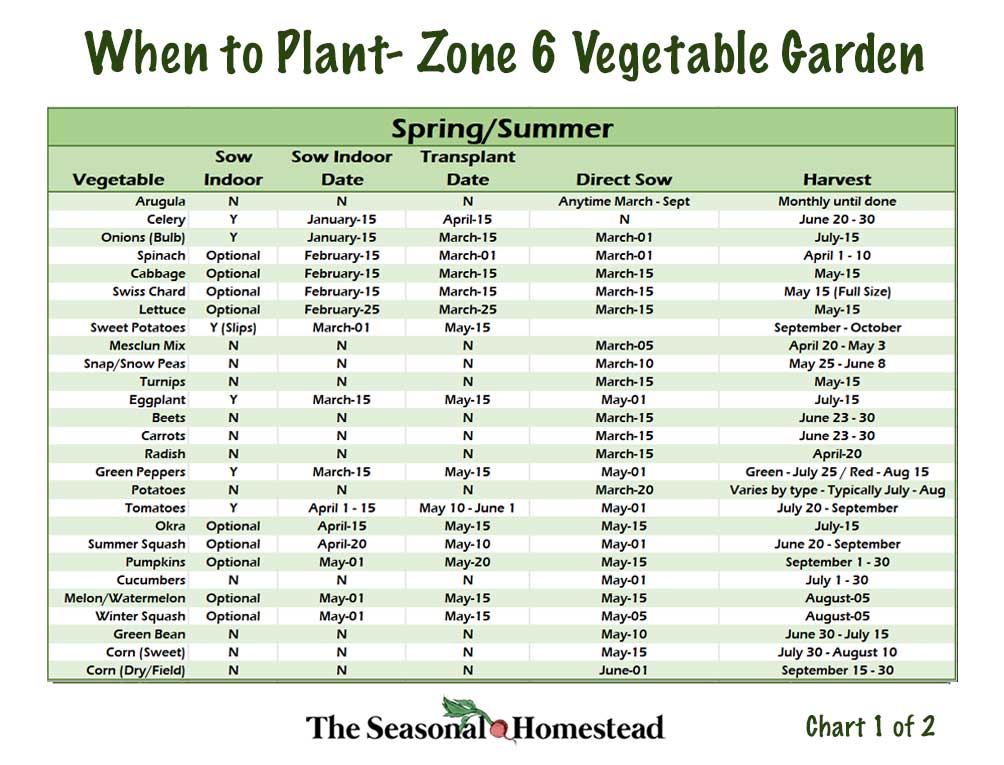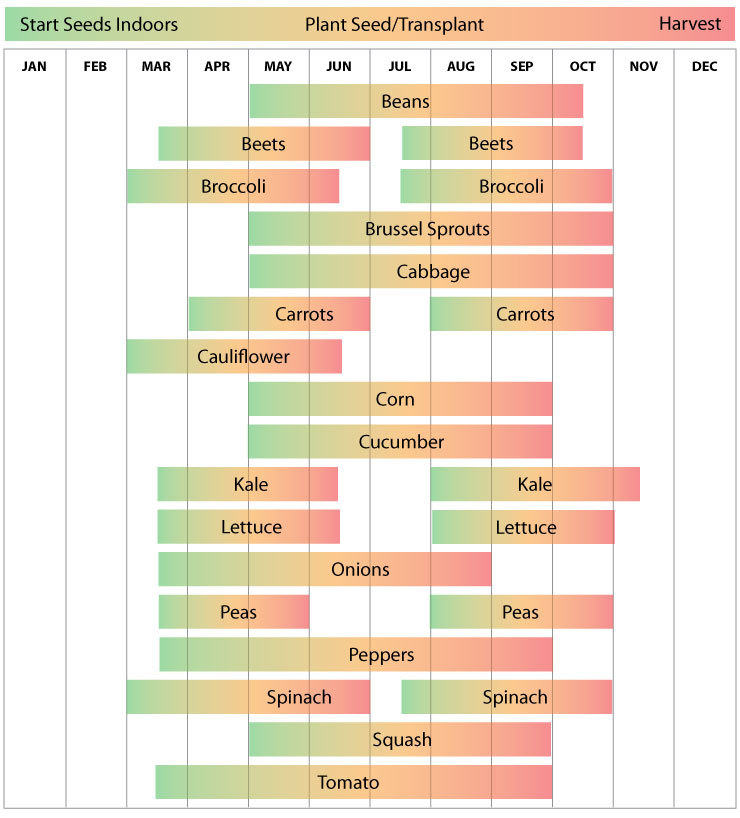Planting Calendar For Zone 6: A Information To Gardening Success
Planting Calendar for Zone 6: A Information to Gardening Success
Associated Articles: Planting Calendar for Zone 6: A Information to Gardening Success
Introduction
With enthusiasm, let’s navigate via the intriguing matter associated to Planting Calendar for Zone 6: A Information to Gardening Success. Let’s weave attention-grabbing info and provide contemporary views to the readers.
Desk of Content material
Planting Calendar for Zone 6: A Information to Gardening Success

Zone 6, with its various microclimates and distinct seasons, presents a rewarding but difficult setting for gardeners. Understanding the nuances of your particular location inside Zone 6 – together with elevation, proximity to water, and soil sort – is essential for maximizing your backyard’s potential. This complete planting calendar offers a common guideline for Zone 6 gardeners, specializing in common final frost dates and optimum planting instances for a wide range of standard crops. Keep in mind to at all times seek the advice of native climate forecasts and regulate planting instances accordingly.
Understanding Zone 6:
USDA Plant Hardiness Zone 6 encompasses areas with common annual minimal temperatures starting from -10°F to 0°F (-23°C to -18°C). Which means whilst you’ll expertise distinct seasons, together with a interval of arduous frost, the rising season is usually longer than in colder zones. Nevertheless, late spring frosts and early autumn chills are widespread occurrences that may injury tender crops. Due to this fact, cautious planning and frost safety methods are important.
Key Concerns earlier than Planting:
- Your Microclimate: Even inside Zone 6, circumstances can differ considerably. North-facing slopes are usually cooler and shadier than south-facing slopes. Proximity to our bodies of water can average temperatures, extending the rising season. Observe your personal backyard’s circumstances – solar publicity, wind patterns, soil drainage – earlier than finalizing your planting plan.
- Soil Testing: Conduct a soil check to find out your soil’s pH and nutrient ranges. Amend your soil with compost or different natural matter to enhance its construction, drainage, and fertility.
- Seed Beginning: Beginning seeds indoors 6-8 weeks earlier than the final anticipated frost permits for a head begin, particularly for slower-growing greens and flowers. This ensures an extended harvest interval.
- Frost Safety: Be ready to guard your crops from late frosts with row covers, cloches, and even easy sheets draped over weak seedlings.
Zone 6 Planting Calendar:
This calendar offers a common guideline. All the time examine your native climate forecast and regulate planting instances accordingly. The dates offered are approximate and primarily based on common final frost dates for Zone 6.
Spring (March – Could):
-
Early Spring (March):
- Begin Seeds Indoors: Tomatoes, peppers, eggplant, basil, zinnias, petunias, and different warm-season crops.
- Plant Cool-Season Crops: Lettuce, spinach, kale, peas, radishes, and onions may be planted straight outdoor as quickly as the bottom is workable. Think about using a chilly body to increase the season.
- Put together the Backyard: Clear up backyard beds, amend soil, and start getting ready for planting.
-
Mid-Spring (April):
- Transplant Seedlings Outdoor: As soon as the hazard of frost has handed (normally round mid-April to early Could in most Zone 6 areas, however this varies broadly), transplant your seedlings outdoor. Harden them off steadily earlier than transplanting to stop shock.
- Direct Sow: Proceed planting cool-season crops like carrots, beets, and chard.
- Plant Potatoes: Plant seed potatoes or potato begins.
- Plant Bulbs: Plant summer-blooming bulbs like dahlias and gladiolus.
-
Late Spring (Could):
- Plant Heat-Season Crops: Plant warm-season greens like tomatoes, peppers, cucumbers, squash, and beans.
- Plant Flowers: Plant annual flowers like marigolds, cosmos, and sunflowers.
- Proceed Planting: Proceed planting succession crops of lettuce and different cool-season greens for a steady harvest.
Summer time (June – August):
-
Early Summer time (June):
- Keep the Backyard: Water often, particularly throughout dry spells. Weed often to stop competitors for vitamins and water.
- Fertilize: Apply fertilizer as wanted to help plant progress.
- Pest and Illness Management: Monitor for pests and ailments and take acceptable motion.
-
Mid-Summer time (July):
- Harvest: Start harvesting summer season crops like beans, zucchini, and cucumbers.
- Succession Planting: Plant a second spherical of fast-growing crops like lettuce and radishes.
- Deadheading: Deadhead spent flowers to encourage extra blooms.
-
Late Summer time (August):
- Harvest: Proceed harvesting summer season crops.
- Put together for Fall: Start planning for fall planting. Begin seeds indoors for fall crops like spinach and lettuce.
Autumn (September – November):
-
Early Autumn (September):
- Plant Cool-Season Crops: Plant cool-season greens like kale, spinach, lettuce, and turnips.
- Plant Fall Bulbs: Plant spring-blooming bulbs like tulips, daffodils, and hyacinths.
- Harvest: Harvest remaining summer season crops and start harvesting fall crops.
-
Mid-Autumn (October):
- Clear Up Backyard Beds: Take away useless crops and particles.
- Defend Tender Vegetation: Defend tender crops from frost with row covers or different frost safety strategies.
- Put together for Winter: Mulch backyard beds to guard crops from frost and retain soil moisture.
-
Late Autumn (November):
- Winterize the Backyard: Clear up backyard beds, take away useless crops, and put together for winter.
- Plant Winter Greens: In milder areas of Zone 6, you could possibly plant some winter greens like kale and collard greens.
Winter (December – February):
- Winter Relaxation: The backyard is essentially dormant throughout winter. Deal with planning for the following rising season. It is a nice time to order seeds, plan your backyard format, and browse gardening books.
Particular Plant Concerns:
- Tomatoes: Require heat soil temperatures (60-70°F) and loads of sunshine. Begin seeds indoors 6-8 weeks earlier than the final frost.
- Peppers: Comparable necessities to tomatoes; begin seeds indoors.
- Beans: Simple to develop; direct sow after the final frost.
- Lettuce: Tolerates cool temperatures; may be sown in early spring and fall.
- Carrots: Want unfastened, well-drained soil; direct sow.
- Flowers: Select varieties suited to your solar publicity and soil circumstances. Many annuals may be began from seed or bought as transplants.
Conclusion:
This planting calendar affords a framework for profitable gardening in Zone 6. Keep in mind that microclimates and climate patterns can considerably have an effect on planting instances. Observe your backyard, adapt to the circumstances, and benefit from the rewards of a bountiful harvest! Constant monitoring, changes primarily based on climate, and a willingness to study and adapt will result in a thriving backyard all through the seasons. Blissful gardening!








Closure
Thus, we hope this text has offered precious insights into Planting Calendar for Zone 6: A Information to Gardening Success. We hope you discover this text informative and helpful. See you in our subsequent article!
Leave a Reply